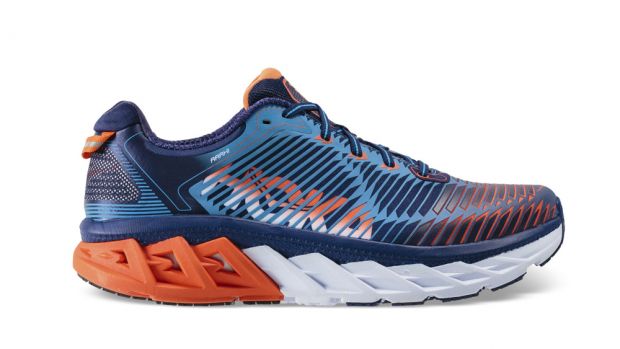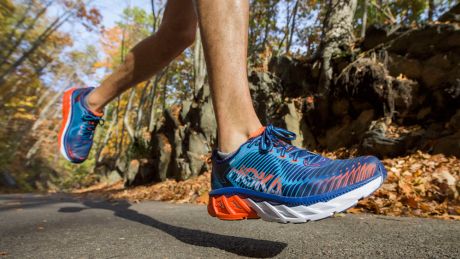You can trust Coach
It only takes one look at Hoka’s shoes to realise what sets them apart from other brands. There’s a vast amount of cushioning on the sole – so much it almost makes them look comical, but that does translate into an extremely comfortable and supportive shoe.
The Arahi is a prime example of this approach, with plenty of cushioning crammed into its lightweight frame. It also has the same heel-to-toe drop that’s standard on Hoka One One shoes. The sole of the shoe is almost flat (5mm offset on the Arahi, compared to the conventional drop of 10-12mm), something proponents of the style claim can reduce injury – a claim that’s unproven, but worth considering if you struggle with regular niggles.
The Arahi does differ to other Hoka One One shoes in one vital respect – it offers some stability for over-pronators (those whose feet roll excessively inward when landing). This is achieved via a J-shaped piece of foam built into the sole that is positioned around the heel and inner side of the foot. This guides the foot back into the optimum position when running without being as rigid as other support shoes.
While I generally prefer to run in neutral shoes, the amount of stability in the Arahi isn’t great enough to make it uncomfortable and I reckon any runner will enjoy the smooth heel-to-toe transition it provides on steady, flat runs.

It might look like a clompy tank, but the ride in the Arahi is excellent – light on the foot and smooth – especially on steady longer runs. For recovery sessions during a hectic training period, the Arahi is ideal. It offers a huge amount of cushioning and support on road or easy trails to help make the miles ease by.
However, it’s less enjoyable to run in during hill sessions. The smooth transition I enjoyed on the flat disappeared and it became a bit of a slog. Also, although it’s light considering its level of cushioning, it’s still not a shoe for sprints. Whatever the claims of flatter platform shoes regarding injury, I prefer a bigger offset from heel-to-toe when upping the pace or tackling hills, as well as less cushioning.
The upper is fairly narrow around the midfoot but loose at the front. It’s a good fit and doesn’t overheat or annoy on longer runs.
Sign up for workout ideas, training advice, reviews of the latest gear and more.
Hoka One One has positioned the Arahi as a lightweight shoe with loads of cushioning and a touch of support, and it certainly lives up its billing. If you rack up a lot of distance every week, doing some of those miles in the Arahi will be a treat. If you really like the fit and feel, it’ll also work for longer road races. Although the stability features on the Arahi aren’t uncomfortable, if you’d prefer an entirely neutral shoe with the same benefits, the Hoka One One Clifton might be a better choice.
- Best Stability Running Shoes For Overpronation
- Hoka One One Clifton Running Shoe Reviews: Clifton Edge vs Clifton 6 vs Clifton 4
- Hoka One One Mach Running Shoe Review

Nick Harris-Fry is a journalist who has been covering health and fitness since 2015. Nick is an avid runner, covering 70-110km a week, which gives him ample opportunity to test a wide range of running shoes and running gear. He is also the chief tester for fitness trackers and running watches, treadmills and exercise bikes, and workout headphones.

